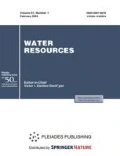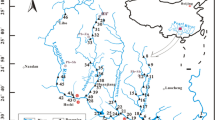Abstract
Macrozoobenthos analyses were used to evaluate the ecological water quality in the Shuya River, a large tributary of Onega Lake, which determines water chemistry in the water intake of Petrozavodsk City, the capital of the Republic of Karelia. Water quality indices, widely used in the world practice, were applied, including FBI, EBI, BMWP, ASPT, BBI, IBGN, GW, EPT, and IM, as well as the integral IBC index. At the average estimate good, the values of indices showed a strong dependence on the characteristics of the station. Samples taken in pool areas with soft soils gave underestimates of water quality indices. The quality classes moderate and good was found in small tributaries, and the quality class excellent, in rapids in the lower reaches of large rivers. It is recommended to evaluate water quality separately for pool areas, small tributaries, and rapids in the main channel; the obtained indices are recommended only to compare similar biotopes. The river ecosystem was found to be in a stable state, comparable with that in the 1980s, notwithstanding the heavier anthropogenic load.


Similar content being viewed by others
REFERENCES
Andriyanova, A.V., Biotic indices and metrics in water quality assessment in small rivers in the territory of Ergaki Natural Park (Southern Krasnoyarsk Krai), Sib. Ekol. Zhurn., 2015, no. 3, pp. 439–451.
Atlas Karel’skoi ASSR (Atlas of Karelian ASSR), Moscow: Glavn. Upravl. Geod. Kartogr. pri Sovmine SSSR, 1989.
Atlas “Respublika Kareliya” (Atlas “Republic of Karelia”), St. Petersburg: 444VKF, 2003.
Baryshev, I.A Zoobenthos of pools of rapid rivers: composition, abundance, and trophic structure (based on the example of Eastern Fennoscandia), Inland Water Biol., 2020, no. 1, pp. 69–87.
Baryshev, I.A., River zoobenthos in Eastern Fennoscandia, Extended Abstract of Doct. Sci. (Biol.) Dissertation, Petrozavodsk: Kar. Nauch. Ts. Ross. Akad. Nauk, 2019.
Baryshev, I.A., The current state and long-term changes in zoobenthos in rapid reaches of the Shuya R. and its tributary, the Syapsya R. (Karelia, Lake Onega basin), in Tr. Gos. prirod. zapovednika “Kivach” (Trans. State Natural Reserve “Kivach”), Iss. 6, Petrozavodsk: Petr. Gos. Univ., 2013, pp. 114–119.
Baryshev, I.A., Formation factors of macrozoobenthos communities in stony rapids and rifts in watercourses of the Eastern Fennoscandia, Zh. Obshch. Biol., 2014, vol. 75, no. 2, pp. 124–131.
Bersonov, S.A., Vodno-energeticheskii kadastr Karel’skoi ASSR (Water-Power Cadaster of the Karelian ASSR), Moscow: Izd. Akad. Nauk SSSR, 1960.
Vvedenie v biomonitoring presnykh vod (Introduction in Freshwater Biomonitoring), Vshivkova, T.S., Ivanenko, N.V., Yakimenko, L.V., Drozdov, K.A., Ed., Vladivostok: Izd. VGUES, 2019.
Golovatyuk, L.V. and Zinchenko, T.D., Biotic identifiers in water quality assessment of a reference river: comparative analysis of bioindication indices of the Baitugan River (Vysokoe Zavolzh’e), Uch. Zap., Kazan. Gos. Univ., Ser. Estestv. Nauki, 2020, vol. 162, book 1, pp. 134–150.
Gosudarstvennyi doklad o sostoyanii okruzhayushchei sredy Respubliki Kareliya v 2019 g. (State Report on the Environmental Conditions in the Republic of Karelia in 2019), Gromtsev, A.N, Kuznetsov, O.L., Shkiperova, G.T., Eds., Petrozavodsk: Min. Prirod. Resursov Ekol. Resp. Karelii, 2020.
Zhadin, V.I., Fauna of rivers and reservoirs, Tr. Zool. Inst., 1940, vol. 5, nos. 3−4.
Ignat’eva, N.V., Petrova, T.N., and Guseva, M.A., Estimate of surface water pollution in Lake Ladoga drainage basin by hydrochemical characteristics, Izv. Samar. NTs RAN, 2015, vol. 17, no. 6, pp. 91–96.
Kareliya. Entsiklopediya (Karelia. Encyclopedia), Petrozavodsk: Petropress, 2007, vol. 1.
Kachestvo poverkhnostnykh vod Rossiiskoi Federatsii. Ezhegodnik 2018 (Surface Water Quality in the Russian Federation. Yearbook 2018), Trofimchuk, M.M., Ed., Rostov-on-Don: GKhI Rosgidrometa, 2019.
Komulainen, S.F., Ekologiya fitoperifitona malykh rek Vostochnoi Fennoskandii (Phytoperiphyton Ecology of Small Rivers in Eastern Fennoscandia), Petrozavodsk: Kar. Nauch. Ts. Ross. Akad. Nauk, 2004.
Komulainen, S.F., Kruglova, A.N., and Baryshev, I.A., Formation of hydrobiocenoses in the Syapsya R. (Onega Lake Basin) under the effect of a trout farm wastes, Rybov. Ryb. Khoz., 2007, vol. 2, pp. 21–23.
Kukharev, V.I., Zoobenthos as an indicator of anthropogenic load on watercourses in the Shuya R. basin, in Elementy ekosistemy Onezhskogo ozera i ego basseina (Ecosystem Elements of Lake Onega and Its Basin), Petrozavodsk: KarNTs AN SSSR, 1984, pp. 34–37.
Lozovik, P.A., Hydrogeochemical criteria of surface water state in the humid zone and their tolerance to anthropogenic impact, Extended Abstract of Doctoral (Chem.) Dissertation, Moscow: Geoekologiya, 2006.
Opekunova, M.G., Bioindikatsiya zagryaznenii. Ucheb. posobie (Bioindication of Pollution. A Textbook), St. Petersburg: Izd. SPbGU, 2016.
Otsenka chislennosti postoyannogo naseleniya na 1 yanvarya 2020 goda i v srednem za 2019 g. (Estimate of the Residential Population as of January 1, 2020, and on the Average over 2019), Moscow: Rosstat, 2019. URL: https://showdata.gks.ru/report/278932/. Accessed April 13, 2020.
Resursy poverkhnostnykh vod SSSR. Kareliya i Severo-zapad (USSR Surface Water Resources. Karelia and Northwest), 1972, vol. 2.
Semenchenko, V.P. and Razlutskii, V.I., Ekologicheskoe kachestvo poverkhnostnykh vod (Ecological Quality of Surface Water), Minsk: Belorus. Nauka, 2010.
Smirnov, Yu.A., Kruglova, A.N., Komulainen, S.F., Khrennikov, V.V., Shirokov, V.A., Shustov, Yu.A., and Shchurov, I.L., Effect of forest and agricultural melioration on elements of the biological regime of the Syapsa and Shuya rivers, in Biol. resursy vnutr. vodoemov i ikh ispol’z.: Mezhvuz. sb. nauch. tr. (Biological Resources of Inland Water Bodies and Their Use: Coll. Sci. Pap.), Petrozavodsk: Petrozav. Gos. Univ., 1990, pp. 89–96.
Sterligova, O.P., Il’mast, N.V., Kuchko, Ya.A., Komulainen, S.F., Savosin, E.S., and Baryshev, I.A., Sostoyanie presnovodnykh vodoemov Karelii s tovarnym vyrashchivaniem raduzhnoi foreli v sadkakh (The State of Freshwater Bodies in Karelia with Commercial Breeding of Rainbow Trout), Petrozavodsk: KarNTs RAN, 2018.
Tekanova, E.V., Kalinkina, N.M., and Kravchenko, I.Yu., Geochemical features of biota functioning in Karelian water bodies, Izv. Akad. Nauk, Ser. Geogr., 2018, no. 1, pp. 90–100.
Temerev, S.V., Ecological–chemical assessment of the state of water system in the Ob Basin, Extended Abstract of Doctoral (Chem.) Dissertation, Moscow: RUDN University, 2008.
Chernov, V.K., Results of hydrobiological studies of the Suna, Shuya, Lososinka rivers and the Kosamskii channel, Tr. Borodinskoi Biol. St., 1927, vol. 5, pp. 190–202.
Chertoprud, M.V., Diversity and classification of rheophilic communities of macrozoobenthos in middle latitudes of European Russia, Biol. Bull. Rev., 2011, vol. 72, no. 1, pp. 165–184.
Shirokov, V.A., Khrennikov, V.V., and Kruglova, A.N., The effect of forest and agricultural melioration on the biological regime of the Shuya R., in Biol. i rybokhoz. issled. vodoemov Pribaltiki, Tez. dokl. XXI nauch. konfer. po izucheniyu i osvoeniyu vodoemov Pribaltiki i Belorussii (Biological and Fishery Studies of Water Bodies in the Baltic Region, Abstr. Rep. XXI Sci. Conf. Studying and Development of Water Bodies in the Baltic Region and Belarus), Pskov: Promrybvod, 1983, vol. 1, pp. 126–127.
Electronic Atlas of the Republic of Karelia. http://nwpi.krc.karelia.ru/atlas/. Accessed November 6, 2020.
Yakovlev, V.A., Presnovodnyi zoobentos severnoi Fennoskandii (raznoobrazie, struktura i antropogennaya dinamika) (Freshwater Zoobenthos of Northern Fennoscandia (The Diversity, Structure, and Anthropogenic Dynamics)), Apatity: Kola Research Center, Russian Academy of Sciences, 2005, Part 1, Part 2.
AFNOR (Association Francaise de Normalisation) Essais des eaux. Determination de la biologique global normalise (IBGN). AFNOR. NF T90-350. Paris, 1992.
Armitage, P.D., Moss, D., Wright, J.F., and Furse, M.T., The performance of a new biological water quality score system based on macroinvertebrates over a wide range of unpolluted running-water sites, Water Res., 1983, vol. 17, no. 3, pp. 333–347.
De Pauw, N. and Vanhooren, G., Method for biological quality assessment of watercourses in Belgium, Hydrobiologia, 1983, vol. 100, pp. 153–168.
Ghetti, P.F., I macroinvertebrati nell’analisi dei corsi d’acqua. Indice Biotico: E.B.I. modificato. Manuale di applicazione. Trento: APAT, 1986.
Hammer, Ø ., Harper, D., and Ryan, P., PAST: Paleontological Statistics Software Package for Education and Data Analysis, Palaeontol. Electron., 2001, vol. 4, iss. 1, pp. 1–9.
Hilsenhoff, W.L., An improved biotic index of organic stream pollution, Great Lakes Entomol., 1987, vol. 20, no. 1, pp. 31–39.
Khrennikov, V.V., Baryshev, I.A., Shustov, U.A., Pavlov, V.N., and Ilmast, N.V., Zoobenthos of salmon rivers in the Kola Peninsula and Karelia (north east Fennoscandia), Ecohydrol. Hydrobiol., 2007, vol. 7, no. 1, pp. 71–77.
Lenat, D.R., Water quality assessment using a qualitative collection method for benthic macroinvertebrates, J. North. Am. Benthol. Soc., 1988, vol. 7, pp. 222–233.
Li, L., Zheng, B., and Liu, L., Biomonitoring and bioindicators used for river ecosystems: definitions, approaches and trends, Procedia Environ. Sci., 2010, vol. 2, pp. 1510–1524.
Malaj, E., Peter, C., Grote, M., Kuhne, R., Mondy, C.P., Usseglio-Polatera, P., Brack, W., and Schafer, R.B., Organic chemicals jeopardize the health of freshwater ecosystems on the continental scale, Proc. National Acad. Sci., 2014, vol. 111, no. 26, pp. 9549–9554.
Metcalfe, J.L., Biological water quality assessment of running waters based on macroinvertebrate communities: history and present status in Europe, Environ. Pollut., 1989, vol. 60, pp. 101–139.
Oertel, N. and Salanki, J., Biomonitoring and bioindicators in aquatic ecosystems, in Modern Trends in Applied Aquatic Ecology, Ambasht, R.S. and Ambasht, N.K., Eds., N. Y.: Kluwer Acad./Plenum Publ., 2003, pp. 219–246.
Rosenberg, D.M. and Resh, V.H., Freshwater Biomonitoring and Benthic Macroinvertebrates, New York: Chapman and Hall, 1993.
Sabylina, A.V., Lozovik, P.A., and Zobkov, M.B., Water chemistry in Onega lake and its tributaries, Water Resour., 2010, vol. 37, no. 6, pp. 842–853.
Slukovskii, Z.I. and Polyakova, T.N., Analysis of accumulation of heavy metals from river bottom sediments of the urban environment in the bodies of oligochaetes, Inland Water Biol., 2017, vol. 10, no. 3, pp. 315–322.
Soininen, J. and Kononen, K., Comparative study of monitoring South-Finnish rivers and streams using macroinvertebrates and benthic diatom community structure, Aquatic Ecol., 2004, vol. 38, pp. 63–75.
Worf, D.L., Biological Monitoring for Environmental Effects, Toronto: Lexington Books, 1980.
Funding
This study was supported by financing from the Federal Budget under Governmental Order to Karelian Research Center, Russian Academy of Sciences, 0218-2019-0081.
Author information
Authors and Affiliations
Corresponding author
Additional information
Translated by G.Krichevets
Rights and permissions
About this article
Cite this article
Baryshev, I.A. Evaluating Water Quality in a Large River System in the Northern European Russia by Macrozoobenthos. Water Resour 48, 774–781 (2021). https://doi.org/10.1134/S0097807821050055
Received:
Revised:
Accepted:
Published:
Issue Date:
DOI: https://doi.org/10.1134/S0097807821050055




